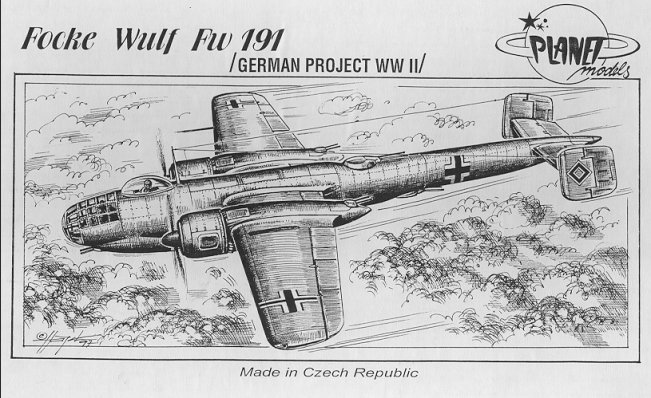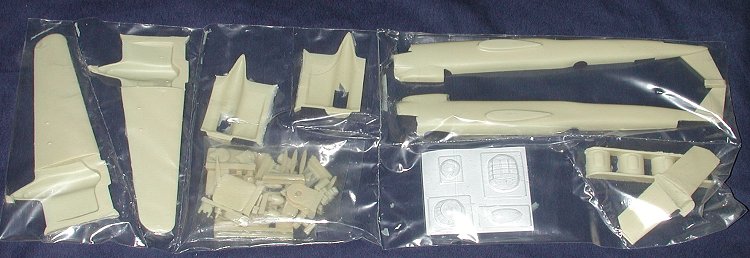
|
KIT: |
Planet Models 1/72 Fw-191 |
|
KIT # |
038 |
|
PRICE: |
$49.95 |
|
DECALS: |
One aircraft |
|
REVIEW & |
|
|
NOTES: |
Resin with vac canopy |

|
HISTORY |
Now I'm not sure if the Luftwaffe had a greater percentage of failed projects for ones that succeeded, than anyone else, but it sure seems like it. This aircraft is one of those. Designed to the bomber requirements of 1939/40, this aircraft along with the Do-317, Ar-340 and Ju-288 was submitted for consideration. The Ar-340 was removed from consideration and the Do-317 put on low priority. The Ju-288 and Fw-191 were given the green light.
A totally unrealistic requirement was that all systems on the aircraft be electrical; no hydraulics or pneumatics were to be used at all. This was only but one of the many things that killed the aircraft. The aircraft that resulted was a very clean design and also a bit unusual in that the gunner's compartment stuck up above the fuselage so that he could see to train his four turreted weapons; two in the back of the engine nacelles and one each above and below the central/aft fuselage. The crew compartment was to be pressurized.
Naturally the design engines, Jumo 222s were not ready for the first flight so BMW 801A radials were substituted. These did not supply the same level of power so the initial prototypes did not perform as expected. Special dive brakes/flaps were also designed into the airframe as the aircraft was supposed to be a dive bomber as well. Trouble was experienced with these control surfaces and was never completely eradicated. Work was abandon on the v3, v4, and v5 prototypes with all efforts going into the improved v6 that had the Jumo 222s. Even these supposed 2,500 hp engines never produced more than 90% of their rated power and since none of the engines of this class designed for the Fw-191, Ju-288 or Do-317 had any chance of actually reaching reliable production status, the entire bomber program was cancelled.
|
THE KIT |

Like all other Planet Models resin kits, this one comes in a nice, sturdy box. All the parts are segregated into several compartments to help eliminate damage from large bits smacking into the fragile ones. For that reason, I have left them in the bag for the photo. Detail on the parts is quite good, consisting of the usual engraved lines. Perhaps the control surface lines could use a bit of deepening to accentuate them a trifle more. Initial inspection of the parts showed no air bubbles and only a small amount of flash. The wings are basically solid resin outboard of the wheel wells so some method of reinforcement such as a brass rod for a spar would be recommended. The four transparencies are in vacuformed plastic and have good detail.
The instructions are barely adequate to build the kit consisting of just an exploded diagram on one side of the sheet with a short history and three view on the other side. The recommended coloring of the plane is overall RLM 63. An odd choice as it is a prewar color. Perhaps painting it in RLM 02 would be more appropriate. Decals are minimal consisting of just national insignia.
Frankly, I could find very little on this aircraft other than what was in the reference. It seems that there just isn't much around on it. I would especially like to hear from anyone who can shed light on the color of the aircraft.
|
REFERENCES |
German Aircraft of the Second World War, by JR Smith & Anthony Kay, Putnam, 1972.
Review kit courtesy of me and my wallet!
If you would like your product reviewed fairly and quickly by a site that averages over 2,000 visits a day, please contact me or see other details in the Note to Contributors.